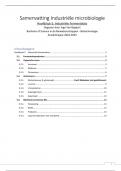Samenvatting
Samenvatting alle stof logica voor informatica
- Vak
- Instelling
- Boek
Deze samenvatting bevat alle stof voor het vak logica voor informatica, van zowel de lectures als het boek. De samenvatting bevat handige tabellen waarin bijvoorbeeld alle regels en alle bewijs strategieën worden samengevat.
[Meer zien]











